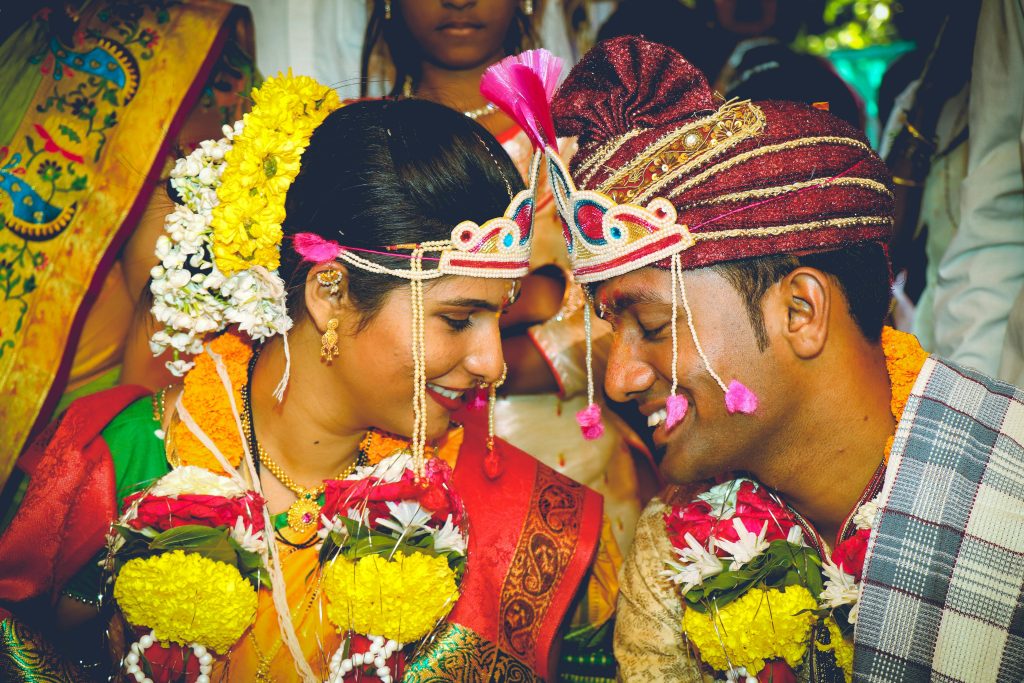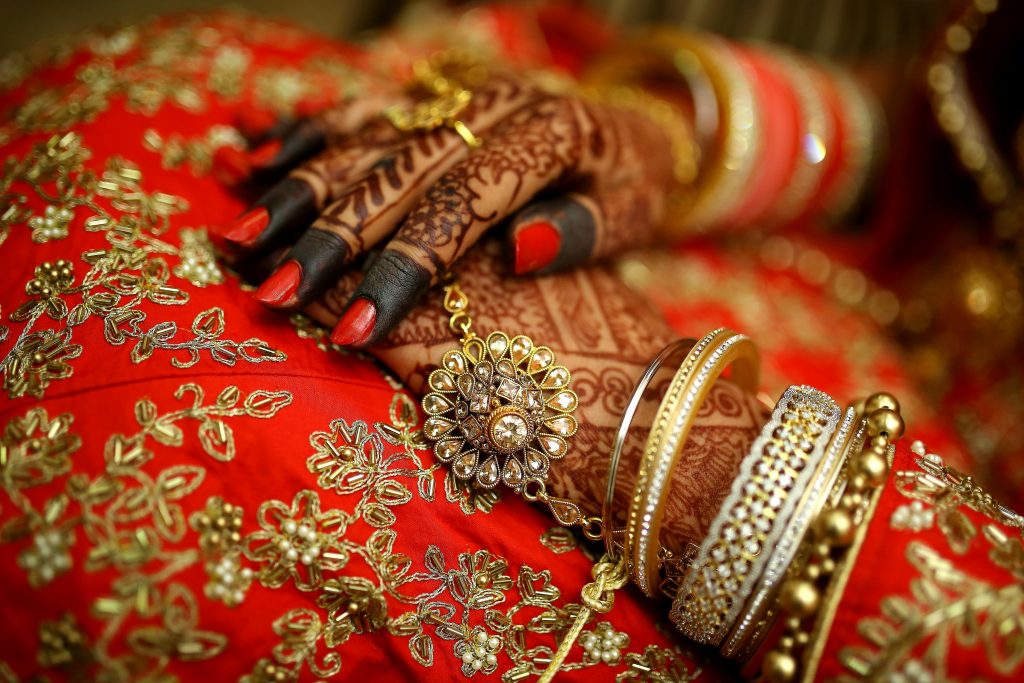If you’ve ever attended an Indian wedding you’ll already know that they are steeped in ancient cultural traditions and come with a lot of color, plenty of laughter, food and dancing. In this article we’ll explore ten unique aspects of the Indian wedding tradition.

First of all, it is important to note that wedding traditions vary across the different regions and religions within India. A Punjabi wedding in the north looks a lot different than a Southern Indian wedding or a Marathi or Bengali wedding. Additionally, although most Indian weddings are Hindu, Islam and Jainist as well as non-religious weddings are found across the country. In this article we will explore popular wedding traditions in India that cover the different regions and faith backgrounds.
1. What is a Traditional Indian Wedding Attire?
You’ll see a lot of different shades of red, orange and pink mixed with strands of sparkling gold. Women, including the bride, traditionally wear a sari – a long dress that flows down below the ankle or a shorter skirt known as a “lengha.” Men typically wear a long shirt known as a “sherwani” with flowing pants to match.
The most prominent aspect of Indian wedding attire is that it is colorful, imaginative and flowing. In contrast to typical Western wedding attire which is usually quite tight and less multi-colored, Indian clothing expresses a more flamboyant style.
2. How many people to expect at an Indian wedding?
You can count on most Indian weddings being massive gatherings. It’s tradition in India to invite pretty much everyone you know to your wedding even if they are only a distant friend or you met them once on the street. Weddings often consist of 400 people or more!
3. The Turmeric Paste Tradition
The Haldi ceremony, as it is called in the Hindu wedding tradition, turmeric paste is applied to the bride’s forehead and face for good luck and beauty. This tradition takes on a number of different names as well. For example, in Jain weddings it is known as Bana Betai and in the Punjabi tradition is referred to as Vatna.
4. What is the Mehndi Ceremony?
The Mehndi ceremony is an ancient South Asian tradition, where intricate henna patterns are drawn onto the hands and feet of the bride at least one day before the wedding. These intricate designs are meant to symbolize positive attraction and fertility. Henna is typically a dark brown color, extracted from the mehndi plant. Sometimes the groom’s name is hidden within the design to add an extra little hide and seek component on wedding night. The temporary marks typically last between one and three weeks.

5. The Sangeet Ceremony
Translated from the Sanskrit word for “sung together,” communities the Sangeet is a pre-wedding ceremony filled with dance and other performances to celebrate the couple. This particular celebration used to be over a week long but now is usually celebrated on one day leading up to the wedding. The elderly women will usually join the bride in singing songs, followed by energetic dances and choreographed performances.
6. Groom’s Procession
Another important part of Indian wedding traditions is the massive show for the groom’s arrival known as “baraat.” The groom either rides up to the wedding party riding an elephant, white horse, or fancy car to the sound of loud music and a cheering crowd of wedding guests.
7. Vows Around the Fire
“Saptapadi” or “Saat Phere” as it is known in the Punjabi wedding tradition is an important ritual in many Indian wedding ceremonies. Here the bride and groom tie their ankles together and take seven steps around a sacred fire. With each step they make a different vow for their married life.
8. Joota chupai
After the Baraat, there’s a fun little hiding game. The women from the bride’s family steal the groom’s fancy wedding shoes while he’s walking into the ceremony space. After the ceremony, the groom and his family look for the “Joota” but often come up empty handed. The shoes are only returned for a hefty sum of money.
9. Indian Unity Ceremonies
Like all other traditions, unity ceremonies in India come in all forms across varying cultures. One popular ceremony known as the jai mala is the bride and groom’s exchange of flower garlands. Another, called mandalap, is where the couple join hands under the witness of Agni Devta, or the God of Fire. Then their shawls are tied together to symbolize a strengthening of their bond through marriage. Often the bride will also be presented with a mangalsutra, a sacred necklace which represents pride and dignity.
10. The Indian Wedding Party
With a lot of people to entertain, you can bet that Indian wedding parties can get pretty wild. First of all there’s always a lot of food. Of course traditional curry and rice dishes are to be expected, but there’s generally also some Western food in the mix. Alcohol? Yes, and generally lots of it. You can also expect to see a lot of dancing from Bollywood style acts to the bhangra, a traditional Punjabi dance. The party usually goes into the morning hours of the day after.
Officiate an Indian Wedding Ceremony
Don’t miss the opportunity to officiate an Indian wedding ceremony for one of your friends or family. You can get ordained online for free with a number of online organizations by just filling out a simple form that only takes a couple minutes to complete. We highly suggest getting ordained with American Marriage Ministries. Once ordained, you’ll have access to a library of information to help you learn all the aspects of wedding from writing your speech to filling out the marriage license. Now that you are familiar with some popular Indian wedding traditions, you could include some in your ceremonies!
– Bernard Paul